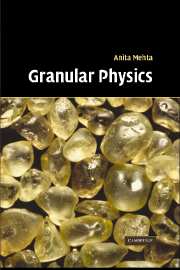Book contents
- Frontmatter
- Contents
- Preface
- 1 Introduction
- 2 Computer simulation approaches – an overview
- 3 Structure of vibrated powders – numerical results
- 4 Collective structures in sand – the phenomenon of bridging
- 5 On angles of repose: bistability and collapse
- 6 Compaction of disordered grains in the jamming limit: sand on random graphs
- 7 Shaking a box of sand I – a simple lattice model
- 8 Shaking a box of sand II – at the jamming limit, when shape matters!
- 9 Avalanches with reorganising grains
- 10 From earthquakes to sandpiles – stick–slip motion
- 11 Coupled continuum equations: the dynamics of sandpile surfaces
- 12 Theory of rapid granular flows
- 13 The thermodynamics of granular materials
- 14 Static properties of granular materials
- References
- Index
- Plate section
Preface
Published online by Cambridge University Press: 06 October 2009
- Frontmatter
- Contents
- Preface
- 1 Introduction
- 2 Computer simulation approaches – an overview
- 3 Structure of vibrated powders – numerical results
- 4 Collective structures in sand – the phenomenon of bridging
- 5 On angles of repose: bistability and collapse
- 6 Compaction of disordered grains in the jamming limit: sand on random graphs
- 7 Shaking a box of sand I – a simple lattice model
- 8 Shaking a box of sand II – at the jamming limit, when shape matters!
- 9 Avalanches with reorganising grains
- 10 From earthquakes to sandpiles – stick–slip motion
- 11 Coupled continuum equations: the dynamics of sandpile surfaces
- 12 Theory of rapid granular flows
- 13 The thermodynamics of granular materials
- 14 Static properties of granular materials
- References
- Index
- Plate section
Summary
This book was commissioned seven years ago, in Oxford, where I was an EPSRC Visiting Fellow at my alma mater, by Cambridge University Press. Its completion in Cambridge, Massachusetts, where I am a Radcliffe Fellow at Harvard University, owes a lot to the tranquillity of my initial and final conditions of work, where I am away from the regular pressures of my permanent position in India.
In the seven years since its conception, many things took priority over its writing, including, to a large extent, the research that has been presented in it. I feel this delay has been largely beneficial. In 1999, many of the developments that now seem obvious, that have now allowed granular media to be the focus of many conferences or multiple sessions at large meetings, were yet to happen. In particular, they changed the conception of the book itself, in my mind.
My initial idea, when I was approached to write a monograph on granular media, was to focus only on those areas where I had some understanding, or where I had myself been active. At that time, it was the so-called statistical mechanics of granular media, pioneered by Edwards, that held centre stage; people like myself were trying to make inroads into the dynamics of these fascinating systems. We focused in particular on what is now known as the jamming limit, which I thought even at the time had fascinating analogies to glasses.
- Type
- Chapter
- Information
- Granular Physics , pp. x - xiiPublisher: Cambridge University PressPrint publication year: 2007

